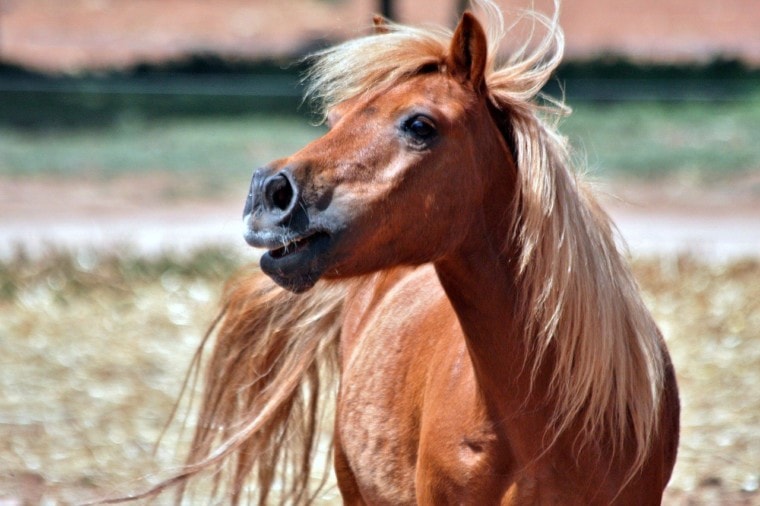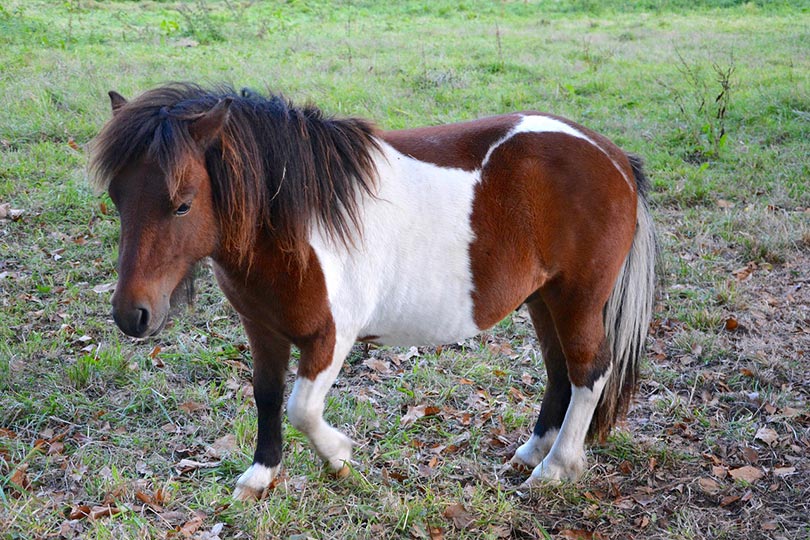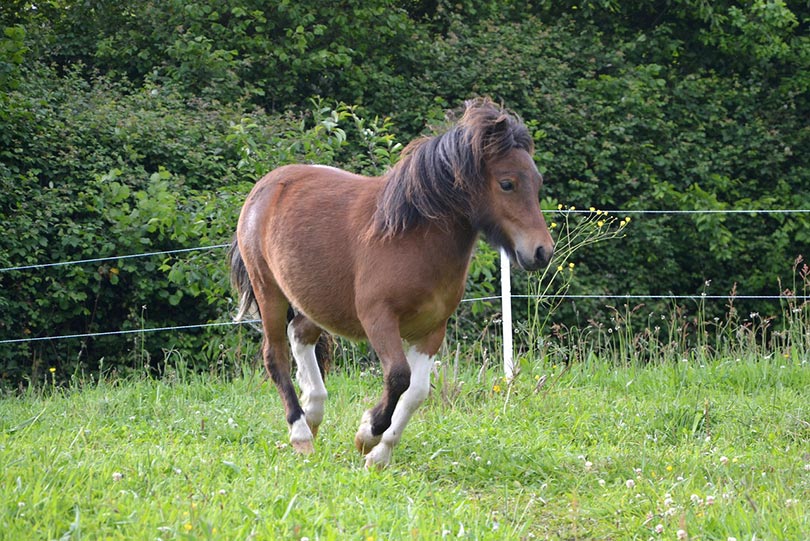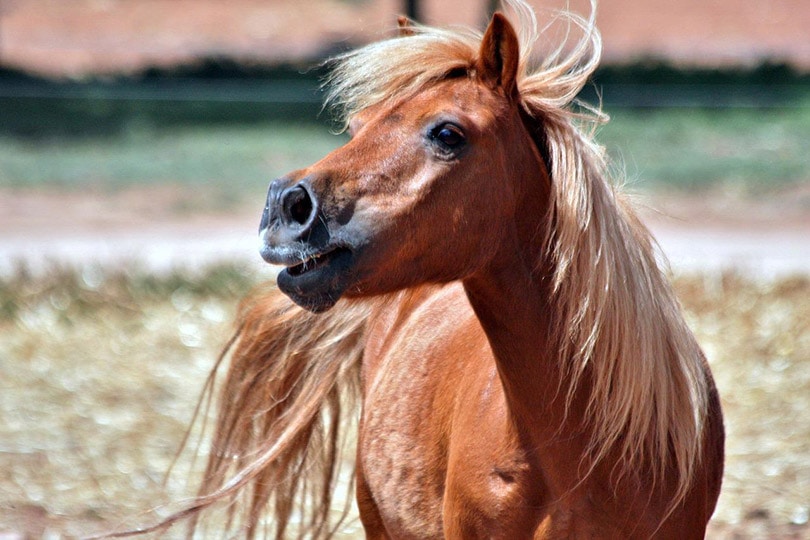
Click to Skip Ahead
The Shetland Pony developed in the Shetland Isles, 100 miles (160km) northeast of Scotland, roughly 4,000 years ago, though their Breed Association was not formed until 1890.1 They are one of the strongest breeds in comparison to their body size, able to pull up to twice their own weight and pack up to half their weight.
They are very popular throughout Europe as children’s mounts, driving ponies, companions, and occasionally as service ponies.2 Their derivative breeds, the German Classic Pony and the American Shetland, are similarly popular in Germany and North America respectively.
Quick Facts About Shetland Ponies

| Species Name: | Equus ferus caballus |
| Family: | Equidae |
| Care Level: | Easy to average; requires the same basic care as other pony breeds. |
| Temperament: | Intelligent; Willing; Courageous |
| Color Form: | All colors except Appaloosa-like spotting. |
| Lifespan: | Average lifespan of 20-30 years; some live into their late 30s and early 40s. The oldest known Shetland, Twiglet, was approximately 50 when he died. |
| Size: | Height: 28” to 42” tall
Weight: approx. 300 to 500 pounds |
| Diet: | Mostly forage [grass, hay, sometimes seaweed]; water; minerals; grain or supplements only if/as needed |
| Enclosure Size: | Minimum – 300ft² in “dry” lots, or 1/2 to 2-1/2 acres of pasture [depending on climate/grass quality]; Maximum – as much space as can be provided. |
Shetland Pony Overview
The Shetland Pony’s exact origins are uncertain, though there are several theories about where and how they may have come to reside in the Shetland Isles. The one that is currently most accepted by the Shetland Pony Stud-Book Society is that they developed from a cross between the now-extinct “Tundra Pony” type that lived in northeastern Siberia and the now-extinct “Mountain Pony” type of Southern Europe, and crossed through Scandinavia to the Shetland Isles area when the land bridges still existed.
This Tundra-Mountain cross was later influenced by the introductions of the Celtic Pony, itself being a Mountain-‘Oriental’ cross, and potentially of stock brought by the Vikings during their occupation of the Isles starting around 8–9th centuries. Regardless of how exactly the Shetland’s ancestors came to the Shetland Isles, only those that were small and hardy enough to survive sparse pasturage and harsh weather were able to thrive, giving rise to the current known breed.

Uses
The ponies have been used by local crofters and fishermen for centuries to help cultivate the land, transport peat (a type of fossil-fuel source found in bogs), seaweed, coal, and other supplies in pack-bags called kishies that were loaded on wooden pack-frames called klibbers, and to turn their tail-hair into fishing lines and nets.
In the mid-1800s, several mine reform bills were passed in the UK, resulting in an abrupt increase of Shetland Ponies being exported from the Isles to take the place of children to pack coal out of the collieries — mostly geldings, but a large number of the best stallions as well. This negatively affected the quality of the animals still being produced in the Shetland Isles, to the point that multiple breeding farms, or studs, were established to remedy this. Particular focus was placed on creating animals that would perform well in the “pits.” The owners of these studs worked together to form the Shetland Pony Stud-Book Society in 1890.
While the use of Shetland Ponies for mining and light agricultural work is no longer what it used to be, they have not decreased in popularity the way other, larger draft breeds did. In modern times, they are most typically found as children’s mounts and as driving ponies, both competitively and for pleasure.
How Much Do Shetland Ponies Cost?
A Shetland Pony’s purchase price depends on a variety of factors, including but not limited to their age, conformation, bloodlines, and showing records. Generally, this will be between $500 and $3,000; in some cases, particularly with stallions and performance horses, they may sell for more than $5,000.
It is difficult to give an estimate of how much these monthly to yearly aspects of pony upkeep will cost, as they vary drastically from region to region, though they will generally be less than that of a full-sized riding horse.
Typical Behavior & Temperament
Shetland Ponies are docile with a willing nature when appropriately trained; their intelligence and general fearlessness can make them rather opinionated, stubborn, and impish otherwise. Each one will have its own personality, however. Some are more suited to being a children’s mount, and others are better off with an adult handling them as driving ponies. They are known to be able to “hold their own amongst much larger ponies.”

Appearance & Varieties
Shetland Ponies that are between 28-34 inches are classed as Miniatures, while those between 35-42 inches are considered to be Standard-sized. Their minimum allowed height is 28 inches, and they are not allowed to be, or exceed, 43 inches. Most show animals are currently around 32 inches. The lines that are bred for draft- or driving purposes tend to be heavier boned than the lighter, springier riding-pony lines, though both are still distinctly Shetland Ponies.
Its hooves are supposed to be tough and well-formed; they were originally formed as such due to having to traverse the rough terrain of the Shetland Isles daily.
They can be any color, except for having Appaloosa-like spotted markings. The most common colors are black, chestnut, grey, and bay. They can also be palomino, buckskin, dun, roan, cremello, and mushroom, among others. Pinto-like markings, referred to as Piebald if black-and-white and Skewbald for most other ‘and-white’ color combinations, are also acceptable.
How to Take Care of Shetland Ponies
Enclosure
According to the UK’s Department for Environmental Food and Rural Affairs [DEFRA], ponies kept in pasture require anywhere from 0.2 to 1.0 hectares (0.5 to 2.5 acres) of grazing per individual if no supplementary feeding is provided; smaller areas can be appropriate if grazing areas are used only for turnout. Temporary cross-fencing can also be used to divide the larger field into smaller sections for rotational grazing.
Fencing should be a minimum of 1 meter (3 feet 3 inches) high, and the Shetland Ponies should be given some form of shade and windbreak, though whether that is in the form of trees/hedges, field shelters, or a stable depends on your personal management choice.
Ponies should not be kept near deadly black walnut trees. While maple tree toxicity is an issue elsewhere, the only native U.K. species (the Field Maple, A. campestre) is not considered dangerous to horses; be aware of if the property your pony is kept on has any imported species.
The recommended minimum size of stall for Shetland Ponies is approximately 3.05 meters x 3.05 meters (10 feet x 10 feet).

Bedding
Shetland Ponies don’t require bedding when kept in pastures or in well-draining paddocks. If drainage is an issue, consider layering hay, straw, or wood shavings on the dry ground of the known problem areas before they are expected to turn muddy.
These materials are good insulators and are absorbent, allowing the ground to thaw out in spring and absorb the early rainwater instead of creating standing puddles. This does not work if the bedding is added on top of existing mud; the mushy ground will just swallow the bedding material instead of creating a nice, dry area.
Make sure that the straw used to bed stalls or create dry patches in turnout is beardless, and that the wood shavings used are from non-toxic wood species. You should avoid black walnut wood products in particular, as it can kill horses.
Climate/Environment
The Shetland Isles are a very windy and harsh environment with winter temperatures remaining barely above freezing, though the ponies’ dense double coats and thick manes and tails allow them to thrive. The outer guard hairs of their coat shed rain, helping to keep them warm and dry. The rough, hilly areas and peat banks of the common grazing areas, or scattalds, provide natural windbreaks to assist them in seeking shelter.

Do Shetland Ponies Get Along with Other Pets?
Shetland Ponies should generally be kept with similarly sized equines, as they are herd animals. It is possible to keep them with larger horses, but the size difference may put them at risk of being kicked in more dangerous locations, such as the head or neck – whenever horses are housed together, they should not wear metal shoes on their hind feet.
If it’s not possible to house them with, or near, another pony or horse, a different companion animal should be considered. Potential alternative species herd mate options include goats, sheep, small cattle, or donkeys. Every horse is different, and may or may not get along with these species.
Dogs can also be a suitable option, so long as they are trained to neither chase nor nip at the ponies. They can be good companions while on trail rides as well.
What to Feed Your Shetland Pony
Shetland ponies tend to be considered ‘easy keepers.’ They have a very high feed conversion rate due to centuries of living off the poor grazing of the scattalds, or common grazing areas that are predominantly heather moorland, paired with eating seaweed found on the beaches—a natural source of many minerals that the grasses lacked.
A primarily forage-based diet – approximately 1 to 1.75 pounds of moderate-quality grass hay per 100 pounds of bodyweight – with some form of ration balancer or mineral supplementation is generally all they require. They should be given little to no grain, as the high level of carbohydrates from concentrates, as well as from richer types of grass or hay, can quickly cause them to become overweight.
Always provide your Shetland pony access to clean, fresh water.

Keeping Your Shetland Pony Healthy
A major cause for concern with Shetland ponies is the health issues related to obesity. Researchers in Australia found that Shetlands had the highest prevalence level of obesity out of all other pony and horse breeds in the study.
Obesity in equines is linked to an increased risk of laminitis, equine metabolic syndrome, joint and tendon issues, and heart stress.
Aside from this, Shetland ponies are very hardy. They should be brushed out before being ridden to help prevent saddle sores from forming due to sweat and dirt existing between the saddle pad and fur, and in spring to assist with shedding.
Annual or twice-annual vet visits should be arranged to address vaccinations, dental examination (which may or may not result in their teeth being floated), and parasite control, in the form of fecal egg count and targeted deworming.
Their hooves should be picked out regularly, and farrier appointments scheduled consistently to maintain their feet, whether through barefoot trimming or shoeing.
Breeding
In 1956, the Shetland Islands Premium Stallion Scheme was enacted. This allows breeders to know the sire of their foals, as the Department of Agriculture provides high-quality registered stallions to seven of the common grazing scattalds.
The Premium Filly and Colt Scheme was put into place in 1983, assisting breeders in keeping their best foals back for future breeding purposes.
Mares are moved from their owners’ arable in-by land to the scattalds in May, for foaling and to run with the registered stallion until September, allowing them to be born into, and breed in, a natural herd environment. There is little, if any, human interference in the process.
Are Shetland Ponies Suitable for You?
If you are looking for a child’s mount, a driving or light draft animal, a pack animal, or even a companion, you should consider the Shetland pony. Its generally docile, willing nature, smaller size, and overall hardiness make it a suitable option for a wide variety of people and situations. With an estimated worldwide population of somewhere around 100,000 Shetland ponies, you should be able to find one that fits your lifestyle.
Always consider meeting with multiple breeders and/or sellers of Shetland ponies before deciding on which pony to purchase. And remember to take a more experienced friend or horse professional, such as your trainer, with you if you’re at all in doubt when you are planning on purchasing one.
Featured Image: Rita_Kochmarjova, Shutterstock









